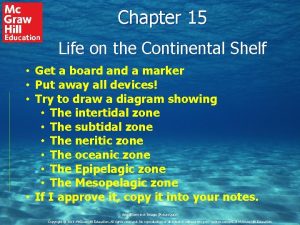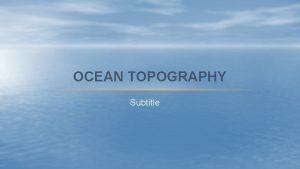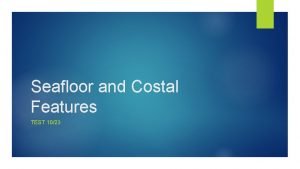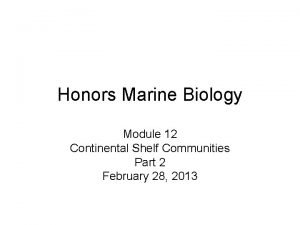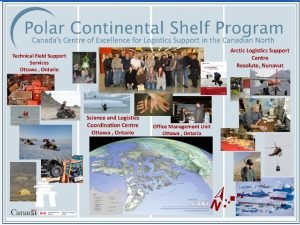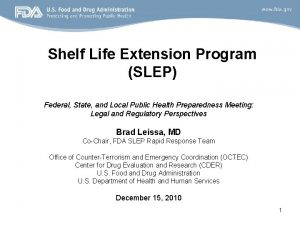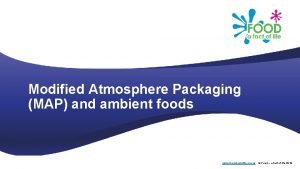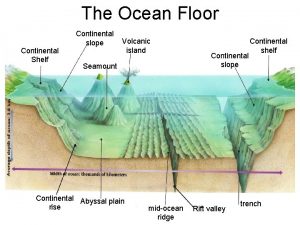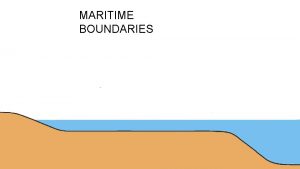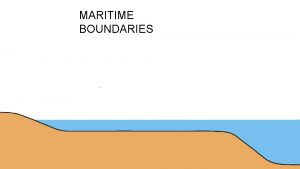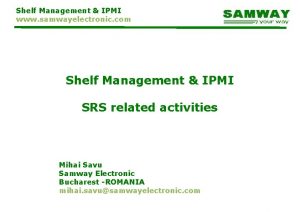Chapter 13 Life on the Continental Shelf Life





















- Slides: 21

Chapter 13 Life on the Continental Shelf

Life on the Continental Shelf • The continental shelf is • • the submerged edge of a continental plate. The shelf extends from the low tide line to an area known as the shelf break. The slope of the continental shelf is normally more gradual, whereas, the slope past the shelf break is normally very steep.

Life on the Continental Shelf • Water turbulence created by waves and currents • • keep the water column well mixed. Nutrients never have a chance to “rain down” on the bottom and be lost the way they do in the deep sea. This constant water motion means the nutrients are available to the benthic organisms as well as those in the neritic zone (the pelagic environment above the continental shelf).

• Pelagic – water column away from bottom or shore • Epipelagic – sea surface to depth of about 200 meters – The epipelagic can be divided into (1) neritic waters over the continental shelf and (2) oceanic waters that are past the shelf

Types of Communities on the Continental Shelf 1. 2. 3. 4. Soft-bottomed benthic Seagrass beds Kelp forests Hard-bottomed benthic

Life on the Continental Shelf • Soft-bottomed benthic- – Dominant bottom type on the continental shelf – Benthos of infauna, epifauna and meiofauna are present as well as _____ species (pelagic species above continental shelf) above the benthos – Sessile types are rare due to lack of “hard substrate” for attachment – There are more species present in this area than in the adjoining intertidal, but the distribution is often patchy

Life on the Continental Shelf • Soft-bottomed benthic– Infauna like snails, clams, urchins, and annelids as well as epifauna like crustaceans and brittle stars. – Many are tubebuilders to assist Generalized Food Chain Detritus from other communities->meiofauna with the stability (ciliate)->deposit (polychaete) & filter feeders (clam) of the habitat.

Life on the Continental Shelf • Meiofauna • Many of these species • are found no where else and include protozoa, cnidarians, crustaceans, nematodes, & annelids These species have appendages and attachment structures to lock themselves to sediment grains

Life on the Continental Shelf • Soft-bottomed benthic- – Bioturbators (organisms that disturb bottom sediments) constantly “churn” the bottom – This churning helps to oxygenate benthic soils – Bioturbators can include worms, mollusks, fish and even whales – Skates and stringrays as well as sperm whales are well known for their activity as bioturbators

Life on the Continental Shelf • Seagrass Beds – They are best developed in sheltered, shallow waters with good water clarity – There are over 50 known species and most common genus is Zostera, commonly called eelgrass – Species have particular tolerance levels with regards to temperature, water clarity and nutrient availability that determines their distribution – Many sessile animals and epiphytic algae


Life on the Continental Shelf • Seagrass Beds – Because of their different tolerances, seagrass species normally prefer either cool waters OR tropical/subtropical waters, but not both normally – They are often found in combination with algal species – The density of individual seagrass plants provides large amounts of detritus

Life on the Continental Shelf • Seagrass Beds – Thalassia (turtle grass) is a common seagrass in tropical and subtropical areas – It is named turtle grass because it is often directly consumed by green sea turtles – In fact, patches of turtle grass have been shown to be “farmed” by individual turtles that bite the tops off the turtle grass. When the tops grow back, they are more tender and easier to digest by green sea turtles – Seagrass (Eelgrass)->Detritus->Filter (clams) and Deposit Feeders (polychaetes)->Herbivores (Sea urchins and fish)->Carnivores (Sea stars, fish, and seabirds)

Life on the Continental Shelf • Hard-bottomed subtidal– Less common – Often, it is the result of a submerged rocky shoreline creating lots of hiding places – Rock formations attract a wide variety of organisms including many sessile types that cannot survive in soft bottomed communities – Oyster reefs, worm tubes and calcareous algae can all serve as hard-bottomed communities as well

Sea _____ grazing on seaweed in a hard bottomed subtidal community

Generalized food web for hard-bottomed subtidal community

Life on the Continental Shelf • Kelp community- – Kelps are ____ algae that are restricted to cold waters in distribution – In addition to requiring cold water, kelps are very nutrient-needy – This is the result of the fast growth seen in these algae (up to 20 inches a day)

Life on the Continental Shelf • Macrocystis is a large species of kelp that can grow heights of over 100 feet • It is found mainly in the Pacific on the coasts of North and South America • This species forms thick forests that serve as a MAJOR ocean ecosystem in the areas where it is found

Geographic distribution of kelps

Life on the Continental Shelf • Kelp community– Sea urchins are by far the largest direct consumer of kelp – In turn, many species feed on the sea urchins including their “cousins” the starfish and sea otters

Life on the Continental Shelf • The diagram • at the right shows the anatomy of a kelp forest Thousands of organisms are dependent on the kelp forests for shelter (habitat) or for trophic needs
 Continental shelf definition
Continental shelf definition Soft bottom subtidal communities
Soft bottom subtidal communities Continental shelf vs slope
Continental shelf vs slope Continental margin
Continental margin Continental shelf
Continental shelf Polar continental shelf program
Polar continental shelf program Convergent vs divergent plate boundaries
Convergent vs divergent plate boundaries Continent continent convergent
Continent continent convergent Cyanokit shelf life
Cyanokit shelf life Life extension
Life extension Salt cured meat shelf life
Salt cured meat shelf life Accelerated shelf life testing calculator
Accelerated shelf life testing calculator Food drink europe
Food drink europe Dosage forms and drug delivery systems
Dosage forms and drug delivery systems Shelf life of first order reaction formula
Shelf life of first order reaction formula Shelf life formula
Shelf life formula Hát kết hợp bộ gõ cơ thể
Hát kết hợp bộ gõ cơ thể Frameset trong html5
Frameset trong html5 Bổ thể
Bổ thể Tỉ lệ cơ thể trẻ em
Tỉ lệ cơ thể trẻ em Gấu đi như thế nào
Gấu đi như thế nào Tư thế worm breton
Tư thế worm breton

